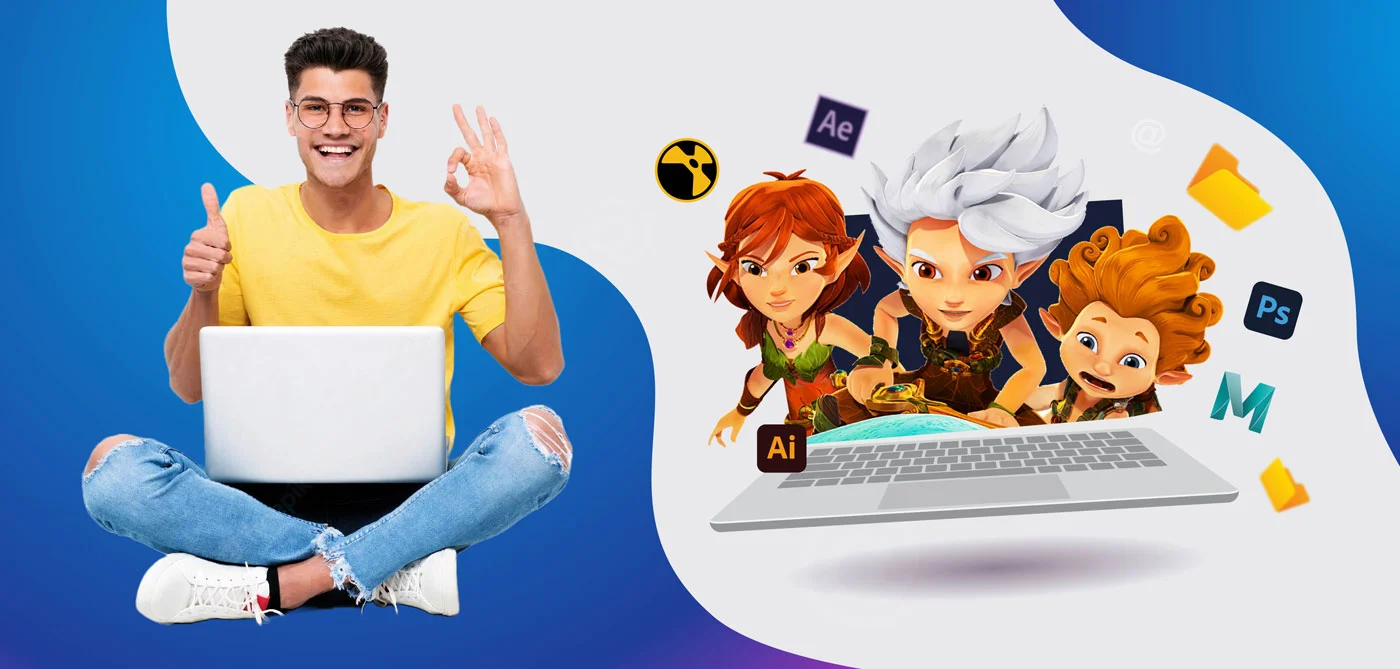
3D Animation and Visual Effects
Overview
Explore the world of digital storytelling through our expansive course in 3D Animation and Visual Effects to learn to make eye-popping art that breathes life into characters and environments. The programme helps you thrive in the animation, gaming industry, film, and advertising fields.
Objectives
- Build a solid core of 3D modelling, rigging, texturing, lighting, and rendering skills.
- Learn Maya, Blender, ZBrush, and Adobe Creative
- Be masters of industry-standard programs like Maya and Mecels.
- Developed 3D animations, both realistic and stylised, for different applications.
- Develop the visual effects and compose theories.
- Create your animation and VFX portfolio.
- Get ready to take a leap into the animation and VFX industry.
Prerequisites
- Interest in visual storytelling + fundamental computer graphics concepts.
- Computer skills and use of basic software.
- You do not need to have any experience in 3D animation or visual effects.
Curriculum Outline
- Introduction for 3D animation and visual effects classes
- History and evolution of animation
- Trends and advancement paths in the field
- A brief in 3D software or tools
- 3D modelling and sculpting
- Working the model using modelling techniques for creating 3D models from scratch
- Creating highly detailed characters and props like digital sculpting tools.
- Rigging and animation
- Scaling, rigging characters or objects
- Animating characters and more with the use of key frame techniques
- How to use MoCap data in animations
- Texturing and materials
- Texturing 3D models with substance designers
- Different materials and shades for realistic vs. stylised effects
- Lighting and rendering
- Basics of lighting and shading
- Realistic lighting, or setting up dramatic lights
- Drawing 3D scenes with different types of renderers
- Visual effects composing
- The Compositing Fundamentals
- -Explosions, fire, smoke, and other visual effects
- Compositing 3D elements into live-action shots
- Portfolio development
- Putting together a portfolio for animating professionally and VFX work
- Tips for networking and finding job opportunities
Teaching Method
- Hands-on experience: exercises or practical projects, reinforcing the theoretical concept.
- Taught by professionals: All of the field-tested curriculum is developed and taught exclusively by industry-experienced professionals.
- Personalised guidance and support so you can succeed.
Modules
- 3D modelling and sculpting
- Rigging and animation
- Texturing and materials
- Lighting and rendering
- Visual effects composing
- Portfolio development
Assessment Methods
- Regular assignments
- Projects
- Exams
- Portfolio evaluation
Course Duration
If you are enrolled in a bachelor's programme, it typically takes 3 or 4 years to complete, while a master's programme typically takes 12 months or 1 year for full-time studies.
However, some countries and universities, such as the UK, allow for part-time studies during your studies, which can result in a master's programme taking longer than 12 months.
Facilities
- Fully equipped, cutting-edge computer labs using popular software
- Animation and visual effects tools at your fingertips
- A stimulating and cooperative classroom
Career Pathways
The animation and visual effects (VFX) industry is changing at a quick pace, and this course can help you get a head start. Learn how to get into the animation and visual effects industries from a well-known professor and alumnus. You can be:
- 3D animator
- Visual effects artist
- Character rigger
- Texture artist
- Lighting technician
- Game developer
- Filmmaker
Fees and Fundings
If you are looking for UK universities, undergraduate (bachelors) degrees cost £12,500 to £19,995 per year.
Entry Requirements
For universities in the UK, you need 112-120 UCAS points; for institutions in other countries, you need A Levels or their equivalents.
Art and design or another creative discipline, including drawing, are required subjects at BBC-BBB.
GCSE: Maths and English language and composition at grade 4 or above.
Students from countries where English is not the native language are required to demonstrate their fluency in the language by obtaining an IELTS score of 6.0 overall, with a minimum of 5.5 in each band. Financial ability to study is also a crucial requirement.
Field Work and Internships
The 3D animation and visual effects programme not only gives you hands-on experience, but it also plots you on a golden path to network with professionals in your field. You will have the chance to:
Get involved in industry-sponsored projects: Collaborate with the pros on actual animation and VFX work.
Intern at the best of studios: Immerse yourself in the best-in-class animation and VFX companies for a real-life experience.
Engage, inspire, and discover career opportunities by networking with industry professionals.
Put your skills to work. Solve problems and work on your creativity.
Certifications
After finishing our 3D Animation and Visual Effects course, you'll be eligible to take exams for credentials that are well respected in the field, including:
- Autodesk Certified Professional (ACP)
- Adobe Certified Expert (ACE)
- Certified Digital Artist (CDA)
Obtaining these credentials not only validates your proficiency but also provides opportunities for advancement and increased responsibilities.
Intakes
If you are interested in studying in the USA, they have winter and summer intakes to get admission, and if you are willing to study in the UK, you can choose the September and January intakes.
Student Testimony
“Falmouth was a massive step for me, I knew no one and couldn’t hop on the bus home after a long day. Yet it’s been amazing and I’ve met and made awesome friends, memories and so many stories.” [Amanda from Falmouth University]
Frequently asked questions
Working as an animation artist opens up a world of opportunities, not only in the UK but around the world. The animation industry is enormous.